For effective leadership, new statistics come out every day, allowing managers to do and become better.
Having the ability to guide and influence individuals in an organization or a company is not something that comes very easily.
However, some leadership statistics can always make a change.
That’s why you should continue reading this article and find out about all the leadership statistics. They might help you transform and improve your business and lead it to success!
Let’s get going!
Here is what you can find out about in this article:
- Statistics On Leadership In The Workplace
- Leadership Development Statistics
- Leadership Burnout Statistics
- Leadership Training Statistics
- Transformational Leadership Statistics
- Youth Leadership Statistics
- Empathy Leadership Statistics
- Female Leadership Statistics
- Thought Leadership Statistics
- Millennial Leadership Statistics
The Most Fascinating Leadership Statistics (Editor’s Pick)
- A share of 38% of new leaders fails within the first 18 months.
- 78% of business leaders focus on improving engagement with employees.
- It is important to develop leaders at all levels for 83% of businesses.
- 77% of companies record leadership gaps.
- Only 19% of organizations think they are effective at developing leaders.
- Six in ten leaders feel used up by the end of the working day.
- Leadership training increases performance by 20%.
- Around 58% of managers did not receive any leadership training.
- Only 29% of senior management positions are held by women.
- Out of Fortune 500 companies, 41 are led by women.
- One in two millennials is in managerial positions already.
Statistics On Leadership In The Workplace
1. The number of 38% of new leaders fail within the first 18 months.
The percentage of new leaders who fail within the first year and a half of being appointed ranges from 38 to 50%. Moreover, even a bigger percentage of them do not live up to the expectations of those who appointed them, according to statistics on leadership in the workplace.
Source: Centre For Creative Leadership
2. Only 10% of people have a natural talent for being leaders.
According to Gallup, only one in 10 people have the natural talent to become leaders, engage with their team members, boost their productivity, and retention. However, another 20% do have some leadership talent that could become the real thing with proper training.
Source: Gallup


3. Staggering 63% of millennials think their workplace doesn’t help to develop their leadership skills.
Deloitte surveyed working millennials and found out that among the least loyal employees, 63% of millennials are likely to say that their workplace does not do enough to help them develop leadership skills. This survey data for millennial leadership statistics are from 2016.
Source: Deloitte
4. 80% of workplace accidents happen because of stress from negative work culture.
Negative work culture will reduce productivity in the workplace and leaders will have to work hard to get it back on track. Why? Because 60% to 80% of workplace accidents happen due to stress from negative work culture. Instead, leaders can acknowledge the efforts of employees and offer incentives for work performance.
Source: American Psychological Association
5. Around 15% of candidates will decline offers from jobs with the negative work culture.
For leaders and their companies to be able to attract talent, they will have to create a positive work culture and spread the word around. Otherwise, 15% of candidates admit they decline offers from jobs with negative work culture.
Source: Builtin
6. Business leaders (78%) focus on improving their engagement with employees.
Business leaders in some industries focus the most on employee retention and engagement. As a matter of fact, almost eight in 10 business leaders are working on improving these two things when it comes to the relationship with their employees in the workplace.
Source: Deloitte


7. Cybercrime is the biggest crisis in the workplace for 73% of board members.
Around 73% of CIOs state that their company experienced leakage of sensitive data in 2020, according to a survey by Microsoft. This is a crisis for many companies and leaders need to learn how to tackle that crisis and come out as even better after them.
Source: Microsoft
8. Post-pandemic, 47% of leaders plan to focus on different scenarios in the new normal.
The post-pandemic workplace will have to look different than what it was before the Coronavirus outbreak in early 2020. That is why 27% of leaders will focus on high-impact unlikely scenarios, while 32% will shift their focus to other more likely additional events.
Source: Deloitte
9. Companies with above-average workplace diversity (45%) earned more from innovation than low-diversity workplace companies (26%).
When the workplace has higher diversity than average, it can generate a larger revenue share from innovation and earn the company more money overall, compared to companies with low diversity.
Source: Levine & Thought Leaders
10. Out of 22 stores that achieved growth in profit, 18 were managed by those rated above average on servant leadership.
Out of 55 similar stores in the same company that participated in the French research by Emylon Business School, 22 stores achieved growth in profit, which is less than half. However, out of those 22, 18 stores had managers who were rated above average on servant leadership. Moreover, this means that servant leadership is what helped them succeed in positive profit growth, according to servant leadership statistics.
Source: Emlyon Business School
Leadership Development Statistics
11. Over eight in 10 businesses find it important to develop leaders at all levels.
Around 83% of businesses think it is important to develop leaders at all levels. However, only around 5% of businesses have managed to do so, implementing leaders at all of their levels. These leadership stats on development are from 2015.
Source: Brandon Hall
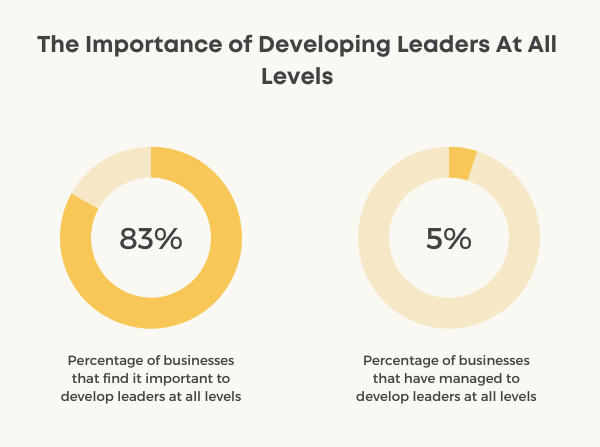

12. One-half of talent development professionals believe companies lack sufficient leadership talent.
The Association for Talent Development surveyed 304 talent development professionals from US companies. Half of these respondents said that there is no sufficient talent for leadership in their company. Moreover, 47% of them said they expect a bigger gap in leadership talent in the future.
Source: Association for Talent Development
13. In 2019, 77% of companies recorded leadership gaps.
The shocking numbers are showing that almost eight in 10 companies experienced leadership gaps in 2019. While candidates like to choose companies that will offer them leadership developments, companies are more likely to employ candidates who already have some level of leadership skills.
Source: Brandon Hall
14. Some 30% of companies fail in creating effective programs for leadership development.
To create a program for leadership development that will be functional, senior management needs to get involved. However, as it is not the case, 30% of companies fail to create an effective leadership development program.
Source: Mercer Mettl
15. Employers have a weak ability to provide leadership development for 77% of millennials.
Millennials are doubting whether their employers can offer them effective leadership development. According to survey data from Canada, 77% of millennials say their employers’ ability to provide them with leadership development is weak.
Source: Human Resources Professional Association
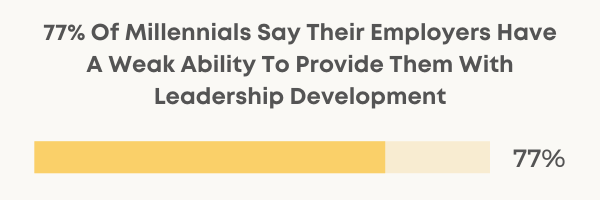

16. Through observation alone, 42% of managers developed their leadership skills.
As many managers do not get the proper training for their position, many (42%) observe the actions of the previous managers to develop their own leadership skills. This is especially true for those who do not get much or any formal training.
Source: West Monroe
17. Only one in 10 CEOs believe their company’s leadership development efforts have a clear impact on the business.
Only 10% of CEOs think that their efforts to develop leadership are actually resulting in a clear impact on the business. On the other hand, 90% do not believe that these can help have a clear impact on the business.
Source: DDI
18. Around the world, $336 billion is spent on leadership development per year.
While $366 billion is spent on leadership development globally every year, the USA alone spends $166 billion on it annually, according to leadership development industry statistics. It is crucial that, with that amount of money being spent, actual effective leadership development programs are made to create an impact.
Source: Training Industry
19. A top challenge for 55% of CEOs is developing the next generation of leaders.
Of course, this is a challenge recognized by most CEOs as a result of more and more employees working from home or demanding hybrid work. That is why leaders now and in the future need to learn how to communicate through digital means. The physical barriers are giving leaders a reason to learn a new set of soft skills while leading at a distance.
Source: Global Leadership Forecast
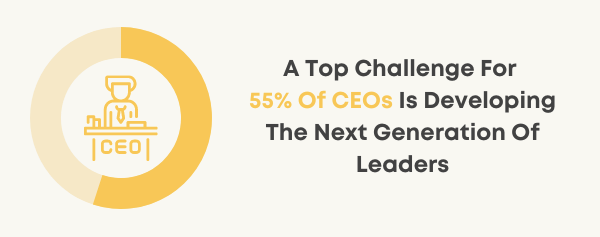

20. Companies that practice inclusive leadership development training are 4.2 times more likely to outperform companies that limit leadership development to management only.
In the Global Leadership Forecast in 2018, it became evident that leadership is not something limited to management levels only. In fact, organizations that offer leadership development training to other levels as well are 4.2 more like to perform better than organizations that only train management levels to become leaders.
Source: The Conference Board/Development Dimensions International
21. Almost every learning organization (95%) plans to invest more or the same in leadership development.
For organizations that specialize in education, leadership development is a big business. As millions of dollars are spent on developing leaders annually, those organizations plan to invest at least the same amount of money before, if not even more.
Source: Chief Learning Officer Business Intelligence Board
22. It costs a company 7% of total annual sales for every year they delay leadership development.
According to the Cost-of-Doing-Nothing-Calculator by The Ken Blanchard Companies, for every year a company delays leadership development, it costs 7% of their total annual sales. This is the difference between companies that develop their leadership and those that don’t. How? Well, not focusing on leadership development influences three key areas: it costs companies employee retention, customer satisfaction, and employee productivity.
Source: The Ken Blanchard Companies
23. Less than one in five organizations think their leaders are good at helping others develop leadership skills.
In the State of Leadership Development 2015 report, Brandon Hall Group concluded that so many companies have a leadership gap, as only 19% of organizations believe their leaders are capable of developing leadership skills in others.
Source: Brandon Hall


24. Around 84% of HR directors believe that the need to develop and upskill leaders will change in the next decade.
In the next decade, according to 84% of HR directors, developing and upskilling areas will see the biggest change. This might result in more hybrid working models, more diversity in the workplace, as well as hiring or promoting more female leaders.
Source: DDI World
25. To be able to guide their development programs, 42% of companies lack a leadership competency framework.
To be able to create an effecting development program for leadership, companies need a leadership competency framework, and 42% of companies don’t have that. According to MMC, 30% of companies accuse senior management of not creating programs for development. Moreover, 22% think those programs are expensive and 25% believe they take too long.
Source: MMC
26. Almost half of the companies rely on development programs to upskill and cross-skill their leaders.
Just under a half (49%) of companies know how to utilize development programs to get their leaders to learn new skills. Also, 31% of companies use those programs to recognize potential leaders, and 20% use them to identify internal successors.
Source: MMC
27. One in five leaders find it hard to adjust to the culture of their new team.
One of the biggest challenges for leaders is the fact 20% of them find it hard to adjust to the new culture. Likewise, leaders also identified other big challenges for them, including low learning agility (20%), inability to network (18%), and lead people (17%), according to statistics on leadership development.
Source: MMC
28. The average time it takes to complete a leadership development program is eight months.
It takes around eight months to finish a leadership development program, according to stats on leadership. These programs should help new leaders learn the skills and prepare future managers for when the old ones retire. Yet, many companies reported that it took them over a year to complete such a program.
Source: Mercer Metti


29. Only 19% of organizations believe they are effective at developing leaders.
As programs take time and money and much more to work, it is not surprising that only 19% of companies think they are good at developing leaders. This is according to Brandon Hall’s State of Leadership Development 2015 report.
Source: Brandon Hall
30. The top priority for 58% of companies is closing the gap on leadership skills.
As around 10,000 Baby Boomers are retiring each day in 2015, and 67% of millennials are looking for a new job, while 84% of companies are expecting to reach a shortfall of leaders in the next few years, it comes as no surprise that 58% of them are looking for a way to close the gap on leadership skills.
Source: Brandon Hall
31. The top priority for 43% of companies is closing the gap across all leader levels.
As the gap on leader levels exists due to many reasons, 43% of companies are prioritizing closing those gaps above other things.
Source: Brandon Hall
32. Only half of the CEOs believe empathy drives productivity and motivation, while 76% of employees say the same.
A report on 2020 State of Workplace Empathy shines insight on empathy leadership statistics. For example, 76% of employees believe that empathy leadership makes them more motivated, compared to 65% in 2019. Moreover, only about 50% of CEOs agree that empathy results in better productivity and more motivation.
Source: Businessolver
Leadership Burnout Statistics
33. Around 60% of employees and employers say their organizations take action to prevent or stop burnout.
While 59% say their organizations do something to prevent or take action against burnout, 29% wish companies would display more empathy along the way. According to The Workforce Institute at Ultimate Kronos Group, burnout is equally concerning for both remote workers and in-house workers at 43%.
Source: Ultimate Kronos Group
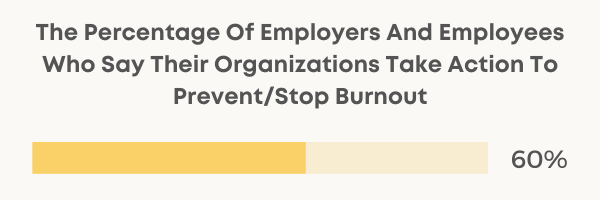

34. Nearly 60% of leaders report feeling used up by the end of the working day.
A strong indication that leaders are burnout comes from the Global Leadership Forecast 2021 report. Namely, almost 60% of leaders say they feel used up at the end of their working day. Out of those who feel like that, 44% expected to change companies to advance in their careers. On the other hand, 26% expected they will leave the company within one year.
Source: Development Dimensions International
35. More than eight in 10 high-potential employees are feeling exhausted.
Those who have a high potential for leadership face major stress. As it turns out, 86% of them say they feel exhausted by the end of their working day in 2021. When compared to 2020, there is a 27% increase in high-potential employees who feel burnt out.
Source: DDI
36. In the US, burnout costs healthcare $190 billion a year.
Employees who suffer from burnout due to stress tend to get disengaged, as well. According to Gallup, disengaged employees due to burnout cost $3,400 out of every $10,000 in salary. Moreover, the Harvard Business Review calculates that burnout costs between $125 billion and $190 billion every year.
Source: The Harvard Business Review
37. The chance for burnout employees and leaders to take more sick days off work is 63% higher.
Compared to employees and leaders who do not experience burnout, those who do are 63% more likely to take more sick days off. Moreover, those employees are also 13% less confident in their work.
Source: Gallup
38. Employees experience a 57% decrease in burnout at work when their leaders connect them to companies’ accomplishments, purposes, and colleagues.
There is a way for employees to experience less burnout, according to leadership burnout statistics. As it turns out, employees see a decrease in burnout of 57% when their leaders help them connect to the accomplishments and purposes of the company, as well as to their colleagues.
Source: O.C. Tanner


39. One in five employees are at a high risk of burnout due to low leadership and employee engagement.
According to a survey by Gallup, 20% of employees are experiencing a high risk of burnout due to the fact they are not engaged and the leadership level is low. This means that leaders have a big impact on the level of employees burnout. However, research shows that over-engagement can also lead to burnout.
Source: Gallup
Leadership Training Statistics
40. Participants in leadership training increase their learning capacity by 25% and performance by 20%.
While leadership training and development programs teach participants about the theory and practices of leadership, they are also given a lot of examples on how to implement those in real office settings. Moreover, this type of training increases the learning capacity of employees by 25% and performance by 20%.
Source: Journal of Applied Psychology
41. Almost six in 10 managers who supervise one to two employees received no management training.
Around 59% of managers who are overseeing up to two employees did not receive any formal leadership training for it. Also, compared to that, 41% of managers who supervise three to five employees did not receive any management training, either.
Source: West Monroe
42. Due to lack of appreciation, 79% of employees quit.
Out of employees who quit their jobs, 79% blame it on lack of appreciation felt by their superiors. That is why leaders need to be trained to show appreciation to their workforce and learn how to support them.
Source: O.C. Tanner
43. Training can lead to a 28% increase in leadership performance.
Out of those who take part in leadership training, 28% show an increase in leadership behavior afterward. However, if there is no proper training and preparation for a leadership role, it more often results in turnover and mistakes.
Source: Journal of Applied Psychology


44. Leadership training market is estimated to increase by $26.7 billion by 2024.
According to Technavio, an already high-value market of leadership training is supposed to increase by $26.7 billion in the next three years. The market will help companies revive their businesses after the impact of COVID-19.
Source: Technavio
45. Around 58% of managers did not receive any leadership training.
A study by CareerBuilder from 2018 shows that around 58% of managers do not receive any leadership training for their roles. On the other hand, it is clear that companies who offer leadership training will perform better than those who do not.
Source: Career Builder
46. Men are 13% more likely to receive leadership training than women.
According to a report from DDI, leadership training is more often given to men than it is to women. The research included over 15,000 leaders and found that men are 13% more likely to receive leadership training than women are.
Source: DDI
47. Managers working in the public sector are 88% more productive when they receive leadership training and executive coaching.
For those who work in the public sector and have the task of managing employees, there is a way to be more productive. According to Science Direct, they will be almost 90% more productive when they receive leadership training and executive coaching.
Source: Science Direct


48. A quarter of managers say leadership training has an impact on business outcomes.
When it comes to positive business outcomes, 25% of managers say leadership training helps them. This training can help employee retention, revenue, engagement rates, and talent acquisition, according to leadership training statistics.
Source: Guide2Research
Transformational Leadership Statistics
49. Team members under transformational leadership show a performance increase of 78.1%.
According to transformational leadership statistics, team members who have a team leader exhibiting a transformational leadership approach show an increase in performance of 78.1%. This data is from a study conducted in Pune, researching 305 IT professionals.
Source: Vilakshan – XIMB Journal of Management
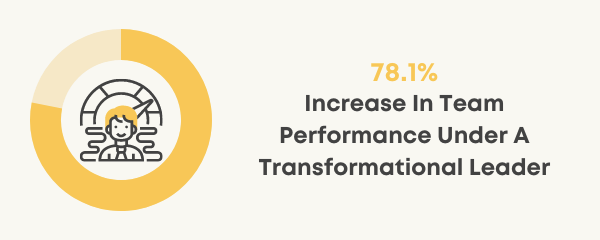

Youth Leadership Statistics
50. Around 1.8 billion people today are aged between 10 and 24 years.
While such a bigger share of the world’s population is aged between 10 and 24, a high number of them live in poverty, according to youth leadership statistics. Also, around 175 million young people who live in underdeveloped countries are unable to read a full sentence. Moreover, over 500 million of those aged between 15 and 24 live on less than $2 a day. Finally, over 73 million are unemployed.
Source: UNFPA
Empathy Leadership Statistics
51. Only four in 10 leaders have the needed empathy skills.
Only 40% of all leaders have the needed empathy skills, according to DDI. They studied 15,000 leaders in high-performing leadership environments and found out that leaders are not showing enough empathy.
Source: DDI
52. 68% of CEOs think organizations are empathic, compared to 48% of employees.
There seems to be a discrepancy in perception of how empathic organizations are between employees and CEOs. While less than half (48%) of employees believe organizations to be empathic, 68% of CEOs also think the same, according to empathy leadership statistics.
Source: Businessolver
Female Leadership Statistics
53. Out of all Fortune 500 companies’ board members, only 15% are women.
Boards need a higher number of women not only for equity but to reap a number of positives that a female board member can bring along. However, only 15% of member boards of directors are women.
Source: The Harvard Business Review
54. Women achieved higher scores in 17 out of 19 categories that distinguish good from bad leaders.
According to a Harvard 360 review from 2019, women outscored men in 17 out of 19 categories when it comes to distinguishing good from bad leaders. Among the categories, they outscored men in communication, relationships, and collaborating.
Source: The Harvard Business Review
55. Between 2015 and 2020, women’s representation in senior management grew from 23% to 28%.
According to a Women in the Workplace 2021 report by McKinsey, the number of women in senior management has grown from 23% to 28%. This number shows a 5% increase over the period of 5 years, between January 2015 and January 2020. Meanwhile, the representation of women grew from 17% to 21% in the C-suite.
Source: McKinsey
56. Only 29% of positions in senior management are held by women.
This is the percentage of women in senior management in North America, while Eastern Europe has 35% of women in senior management, compared to 30% of the level if European Union. Moreover, the percentage of women in senior management is 38% in Africa, 33% in Latin America, and 27% in the Asia Pacific.
Source: Catalyst


57. Out of Fortune 500 companies, 41 are led by women.
In 2020, 37 out of Fortune 500 companies had a female chief executive. This is the all-time high until 2020. Then, in 2021, 41 out of Fortune 500 companies were led by a female CEO.
Source: Fortune
58. Women show more resilience in leadership (54.7%) than men (49.3)%.
As women outperform men in 17 out of 19 categories that separate good from bad leaders, they also show more resilience, the study found. Women are more resilient (54.7%), compared to men (49.3%).
Source: The Harvard Business Review
59. The number of female CEOs rose by 2% in 2020, to 7.8%.
While 2020 was a challenging year for business, women still made progress. During 2020, the percentage of female CEOs grew from 5.8 to 7.8. This makes it a 2% increase in the year that COVID hit the world.
Source: Biz Women
60. Out of leaders during the pandemic, women were more successful leaders in the government response to the pandemic than male leaders.
When it comes to comparing female and male leaders in governments, female-led governments gave a better response to the COVID-19 pandemic. As it turns out, female government leaders of New Zealand, Finland, Germany, Iceland, Norway, and Denmark controlled the COVID outbreak in their countries with a mortality rate of around 1%, compared to the worldwide average of 5%.
Source: ScoopWhoop
61. The number of female-owned businesses has grown from 4.6% in 1972 to 42% in 2019.
While less than 50 years ago barely any businesses were owned by females, in 2019 that number almost reached 50%. Since 2014, that number has grown by 21%, up to almost 13 million.
Source: American Express


62. In 2020, 12.3 million businesses were female-owned and created $1.8 trillion in revenues per year.
While the number of female-owned businesses during the pandemic is high (12.3 million), 30% were forced to temporarily stop their operations as a result of the pandemic. In comparison, only 17% of men-owned businesses had to do the same, according to Facebook, OECD, and World Bank.
Source: Shepherd
63. In 2019, 40% of board openings went to women at the top 100 public companies.
Almost every four in 10 board openings at the top 100 public companies in 2019 went to women. This shows that the increase of representation is happening but it will still take time before the number of women and men in leadership positions is more equal.
Source: FOEW
64. Only 18% of managerial positions in 1972 were held by women, compared to 40% in 2016.
While the number of women in managerial positions has grown by 22% in under half a century, there is still space for progress. Why? Well, women of color have a smaller share of these positions: Latina women 4.3%, black women 4%, and Asian women 2.5%.
Source: Catalyst
65. Latvia is the only country in the EU with the majority of female managers (53%).
While only one in three managers in the EU is female, this number is the highest in Latvia. In fact, in this Baltic state, 53% of all managers are women, according to female leadership statistics.
Source: Eurostat
66. Less than one in three US startups had at least one woman as a founding member in 2020.
Just over a quarter (28%) of all US startups had at least one female founding member in 2020. This grew by 2% since 2019. Moreover, 24% of female founding members of US startups in 2018, and 22% in 2017.
Source: Statista


67. For 100 men hired or promoted to a manager, only 74 women are hired or promoted to a manager.
As for every 100 men who are hired or promoted to a manager, only 74 women get the same treatment. As it turns out, women are more likely to get stuck in the entry levels. Lastly, because of this reason, there are fewer women than men in senior management positions.
Source: McKinsey
68. In 2018, 14.9 million Americans held management positions, including 6.23 million women.
While 6.23 million women held managerial positions in 2019, an even bigger number of men did so. In the USA, that number of American men was 8.68 million.
Source: CompareCamp
Thought Leadership Statistics
69. Due to the pandemic, there has been an increase in thought leadership in the market, according to 66% of decision-makers.
Since the start of the pandemic, there has also been a growth of thought leadership available in the market, 66% of decision-makers say. This data is according to a thought leadership statistics survey of 3,593 business executives worldwide.
Source: Edelman-LinkedIn
70. If the thought leadership content does not grab their attention in the first minute, 55% of buyers report moving on.
When it comes to decision buying, thought leadership can influence it. For instance, according to Edelman-LinkedIn research, more than half (55%) of buyers move on if the thought leadership content does not grab their attention in the first minute.
Source: Edelamn-LinkedIn
Millennial Leadership Statistics
71. In 2014, millennials already represented a majority of the workforce.
The oldest millennials are entering their 40s and by 2025, they should make up for 75% of the workforce. Born between 1981 and 1996, Gallup estimates that the US has around 73 million millennials, according to millennial leadership statistics.
Source: Deloitte


72. One in two millennials are already in managerial positions.
As they make up the majority of the workforce, it makes sense that half of them are already in senior positions and even that the number is growing rapidly. They think that approachability and transparency are essential in business. Also, organizations can meet the needs of millennial leaders by giving them an accessible and collaborative culture, according to 33% of millennials.
Source: Deloitte
73. More than one in three millennials believe the CEO role will no longer be relevant in its current format in the next 10 years.
According to a study by American Express, Redefining the C-Suite: Business The Millennial Way, 35% of American millennials think that the current format of the CEO role won’t be relevant in 10 years. Also, 33% of UK millennials think the same, as well as 43% of French, and 42% of German millennials. Finally, this gives us an average of 39%.
Source: American Express
74. Nine in 10 millennials aspire to leadership roles, but 83% would also prefer to work for companies with fewer managerial levels.
While almost all millennials are showing an interest and aspiration to become leaders, many of them would also prefer to work for a company with less hierarchy. That is, 83% would prefer to work for organizations that don’t have many layers of management.
Source: Workplace Trends
Final Verdict
To sum everything up, many employees and employers believe that leadership is important for a better overall business outcome, not everyone seems to know how to achieve effective leadership. Moreover, a lot of money is invested in leadership training and development programs every year, there is still a lot of space for improvement.


































Find Us on Socials